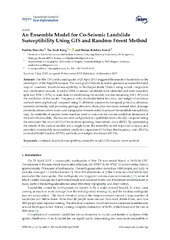| dc.contributor.author | Shrestha, Suchita | |
| dc.contributor.author | Kang, Tae-Seob | |
| dc.contributor.author | Suwal, Madan Krishna | |
| dc.date.accessioned | 2018-02-09T09:50:11Z | |
| dc.date.available | 2018-02-09T09:50:11Z | |
| dc.date.issued | 2017-11-16 | |
| dc.Published | Shrestha, Kang, Suwal MK. An Ensemble Model for Co-Seismic Landslide Susceptibility Using GIS and Random Forest Method. ISPRS International Journal of Geo-Information. 2017;6(11):365 | eng |
| dc.identifier.issn | 2220-9964 | |
| dc.identifier.uri | https://hdl.handle.net/1956/17368 | |
| dc.description.abstract | The Mw 7.8 Gorkha earthquake of 25 April 2015 triggered thousands of landslides in the central part of the Nepal Himalayas. The main goal of this study was to generate an ensemble-based map of co-seismic landslide susceptibility in Sindhupalchowk District using model comparison and combination strands. A total of 2194 co-seismic landslides were identified and were randomly split into 1536 (~70%), to train data for establishing the model, and the remaining 658 (~30%) for the validation of the model. Frequency ratio, evidential belief function, and weight of evidence methods were applied and compared using 11 different causative factors (peak ground acceleration, epicenter proximity, fault proximity, geology, elevation, slope, plan curvature, internal relief, drainage proximity, stream power index, and topographic wetness index) to prepare the landslide susceptibility map. An ensemble of random forest was then used to overcome the various prediction limitations of the individual models. The success rates and prediction capabilities were critically compared using the area under the curve (AUC) of the receiver operating characteristic curve (ROC). By synthesizing the results of the various models into a single score, the ensemble model improved accuracy and provided considerably more realistic prediction capacities (91%) than the frequency ratio (81.2%), evidential belief function (83.5%) methods, and weight of evidence (80.1%). | en_US |
| dc.language.iso | eng | eng |
| dc.publisher | MDPI | eng |
| dc.rights | Attribution CC BY | eng |
| dc.rights.uri | http://creativecommons.org/licenses/by/4.0 | eng |
| dc.subject | co-seismic landslide susceptibility | eng |
| dc.subject | ensemble model | eng |
| dc.subject | GIS | eng |
| dc.subject | random forest method | eng |
| dc.title | An Ensemble Model for Co-Seismic Landslide Susceptibility Using GIS and Random Forest Method | eng |
| dc.type | Peer reviewed | en_US |
| dc.type | Journal article | en_US |
| dc.date.updated | 2018-01-03T09:45:20Z | |
| dc.description.version | publishedVersion | |
| dc.rights.holder | Copyright 2017 The Author(s) | en_US |
| dc.identifier.doi | https://doi.org/10.3390/ijgi6110365 | |
| dc.identifier.cristin | 1534472 | |
| dc.source.journal | ISPRS International Journal of Geo-Information | |

